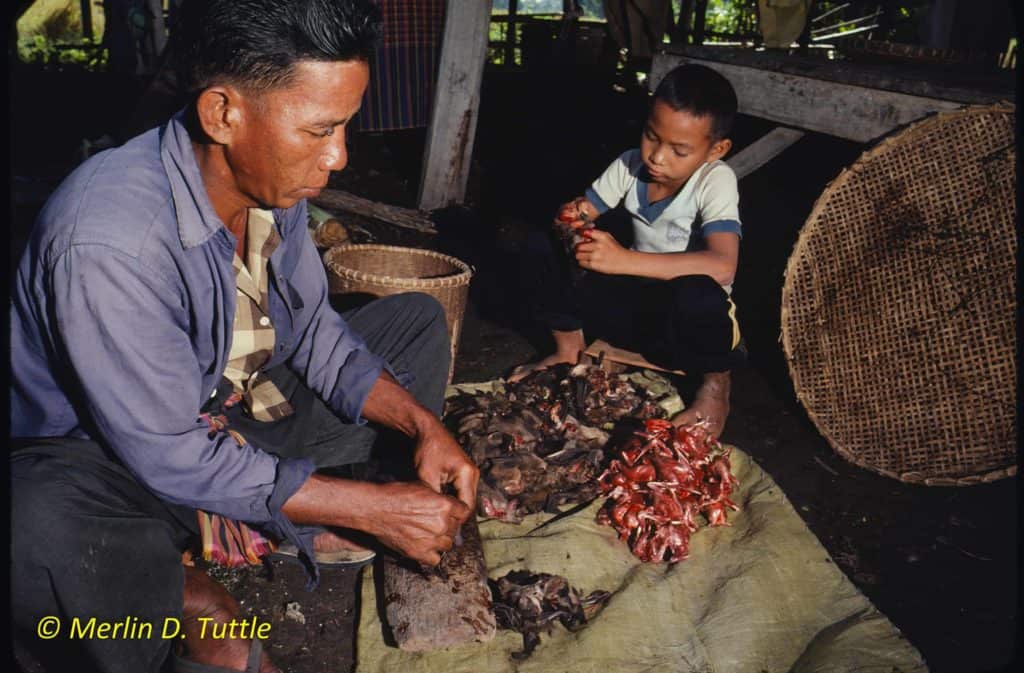The Costs of Bat Decline
Can we afford to lose bats? A recent study by Eyal Frank of the University of Chicago reveals that the dramatic decline in U.S. bat

The Buddhist temple at Khao Chong Pran is said to have been built largely from guano fertilizer sales. When Merlin first visited the site in 1981, monks were alarmed by a precipitous drop in guano production and asked his advice on the problem. He discovered that poachers were killing large numbers of bats by setting nets over the cave entrance late at night when the monks weren’t looking. The bats were sold to restaurants as a food delicacy. After Merlin convinced the monks to hire a guard in 1981, bat guano sales increased from $12,500 U.S. annually to $89,000 within 10 years, and by 2002, annual sales had reached $132,000 U.S. Recently, the guano producing bats had been in gradual decline despite 24-hour protection by a team of four guards, so Merlin was quite pleased to discover several evenings ago that the most likely cause of renewed decline was simple to remedy–remove gradually encroaching vegetation.
The value of Khao Chong Pran’s bats goes far beyond guano sales, though this is the most noticeable contribution that people see. Our video shows workers bringing bags of guano from the cave, dumping it on a floor where it is graded for quality and loaded into labeled bags for sale, mostly hauled off by the pickup load by wholesalers, but also sold to some local residents. Harvests occur once a week under strict supervision by monks and town officials.
Recently, a team of U.S. and Thai scientists collaborated on a study of these bats at Khao Chong Pran Cave, investigating their value in controlling white-backed plant hopper pests that attack rice. Although these bats feed on a variety of pests, including moths, the scientists concluded that the bats’ impact in reducing just this one pest was even more valuable than their guano production. Based on this research the bats from Khao Chong Pran Cave provide pest control in addition to the guano sales.
Love our content? Support us by sharing it!
Can we afford to lose bats? A recent study by Eyal Frank of the University of Chicago reveals that the dramatic decline in U.S. bat
Bats are among the most fascinating yet misunderstood creatures in the natural world, and for many conservationists, a single experience can ignite a lifelong passion
Many bat conservationists know that Kasanka National Park in Zambia is an exceptional place for bats, but it is also the place that sparked my
The Kasanka Trust is a non-profit charitable institution, which secures the future of biodiversity in Kasanka National Park in Zambia. They welcome internships for students
2024 © Merlin Tuttle’s Bat Conservation. All rights reserved.
Madelline Mathis has a degree in environmental studies from Rollins College and a passion for wildlife conservation. She is an outstanding nature photographer who has worked extensively with Merlin and other MTBC staff studying and photographing bats in Mozambique, Cuba, Costa Rica, and Texas. Following college graduation, she was employed as an environmental specialist for the Florida Department of Environmental Protection. She subsequently founded the Florida chapter of the International DarkSky Association and currently serves on the board of DarkSky Texas. She also serves on the board of Houston Wilderness and was appointed to the Austin Water Resource Community Planning Task Force.
Michael Lazari Karapetian has over twenty years of investment management experience. He has a degree in business management, is a certified NBA agent, and gained early experience as a money manager for the Bank of America where he established model portfolios for high-net-worth clients. In 2003 he founded Lazari Capital Management, Inc. and Lazari Asset Management, Inc. He is President and CIO of both and manages over a half a billion in assets. In his personal time he champions philanthropic causes. He serves on the board of Moravian College and has a strong affinity for wildlife, both funding and volunteering on behalf of endangered species.